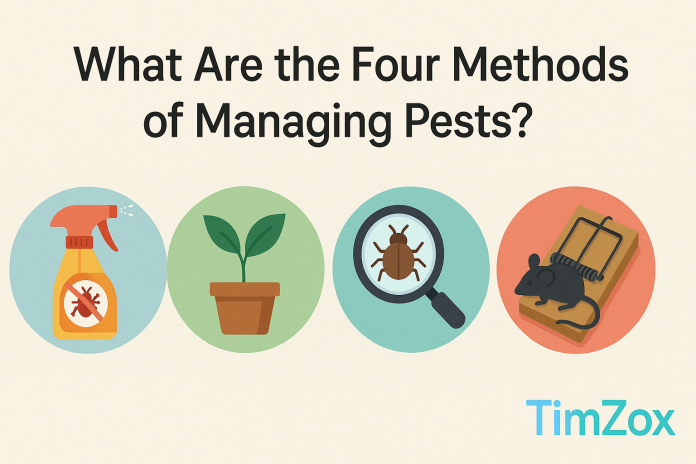Pest control is a fundamental aspect of agriculture, gardening, and public health. Effective pest management ensures higher crop yields, protects human health, and maintains ecological balance. While pests can be destructive, not all need to be eradicated—many can be managed through strategic, sustainable approaches.
There are four main methods of pest control: cultural, mechanical/physical, biological, and chemical. Each method has its strengths and limitations, and they are often combined in a practice known as Integrated Pest Management (IPM).
1. Cultural Pest Control
Definition
Cultural control refers to modifying the environment or agricultural practices to make it less favorable for pests. This proactive method focuses on prevention rather than cure.
Techniques
-
Crop Rotation: Rotating different crops each season to disrupt pest breeding cycles.
-
Sanitation: Removing plant debris, weeds, or infected material that harbor pests.
-
Proper Timing: Planting or harvesting crops at times that avoid peak pest populations.
-
Site Selection and Spacing: Ensuring good air circulation and sunlight, which reduce fungal and insect problems.
-
Water and Nutrient Management: Preventing over-irrigation and over-fertilization, which attract certain pests.
Pros
-
Environmentally friendly
-
Reduces reliance on pesticides
-
Sustainable in the long term
Cons
-
Requires detailed local knowledge
-
May be less effective when used alone in high-pressure infestations
2. Mechanical or Physical Pest Control
Definition
This method involves physically removing, excluding, or killing pests using tools, barriers, or manual methods.
Techniques
-
Barriers and Screens: Nets, row covers, or window screens to block pest access.
-
Traps: Sticky traps, pheromone traps, or light traps for insects and rodents.
-
Handpicking: Manual removal of pests like caterpillars or beetles from plants.
-
Temperature Control: Using cold or heat to kill pests (e.g., soil solarization or freezing storage).
-
Tillage: Disrupting pest life cycles by plowing or cultivating soil.
Pros
-
Immediate results
-
No chemical residues
-
Suitable for organic and small-scale operations
Cons
-
Labor-intensive
-
Impractical for large infestations or farms
-
Requires constant monitoring and maintenance
3. Biological Pest Control
Definition
Biological control uses natural enemies—predators, parasites, and pathogens—to suppress pest populations.
Techniques
-
Predatory Insects: Like ladybugs, lacewings, and spiders that feed on aphids or mites.
-
Parasitoids: Such as wasps that lay eggs in or on pests, eventually killing them.
-
Pathogens: Microbial agents like bacteria (e.g., Bacillus thuringiensis), fungi, or viruses that infect and kill pests.
-
Sterile Insect Technique (SIT): Releasing sterilized males to reduce pest reproduction.
Pros
-
Eco-friendly and target-specific
-
Minimal risk to non-target organisms
-
Can become self-sustaining over time
Cons
-
Slow to act compared to chemicals
-
Potential for imbalance if non-native species are introduced
-
Often requires expert knowledge and management
4. Chemical Pest Control
Definition
Chemical control involves using synthetic or natural substances (pesticides) to kill or repel pests. It is the most commonly recognized method and can be very effective when used responsibly.
Types of Pesticides
-
Insecticides: Kill insects (e.g., ants, beetles, aphids)
-
Herbicides: Eliminate unwanted plants or weeds
-
Fungicides: Control fungal infections on plants
-
Rodenticides: Target rats, mice, and other rodents
-
Nematicides: Control harmful nematodes in soil
Pros
-
Fast-acting and highly effective
-
Useful in large-scale farming
-
Can be precisely applied with modern formulations
Cons
-
Potential for pesticide resistance
-
Environmental pollution (soil, water, and air)
-
Health hazards if misused
-
May harm beneficial insects and animals
Integrated Pest Management (IPM): The Best of All Worlds
Integrated Pest Management (IPM) is a holistic strategy that combines all four pest control methods to manage pest populations at acceptable levels while minimizing harm to the environment, economy, and human health.
Core Steps in IPM
-
Monitoring: Regular scouting to detect pest presence and population levels.
-
Correct Identification: Accurately identifying the pest species involved.
-
Setting Action Thresholds: Determining pest population levels that warrant action.
-
Choosing Control Methods: Selecting the most effective and least disruptive methods.
-
Evaluation: Reviewing the outcome to refine future pest management decisions.
Advantages of IPM
-
Sustainable and cost-effective
-
Reduces pesticide use and environmental impact
-
Protects beneficial species and biodiversity
-
Encourages long-term pest control solutions
Read Also: Anywherestory.net: Share Travel Stories With the World
Conclusion
Understanding and applying the four major pest control methods—cultural, mechanical, biological, and chemical—is essential for effective and sustainable pest management. Each method plays a distinct role and has its place depending on the context, pest type, and desired outcome.
When used together through Integrated Pest Management, these methods offer a powerful, environmentally conscious, and economically viable solution to pest problems. The goal is not always to eliminate pests entirely, but to manage them in ways that protect crops, ecosystems, and human well-being.


